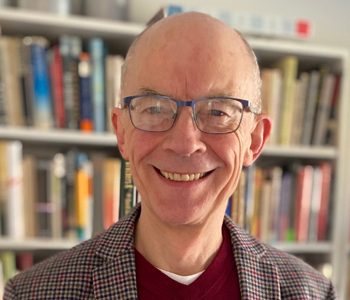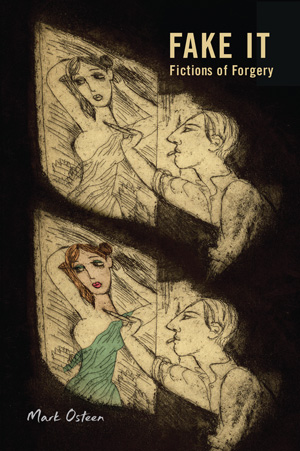
Fake It investigates a set of fictional literary and art forgeries and hoaxes alongside their real-life inspirations that range from the 1660s to the twenty-first century. In the prologue, I present fifteen theses that distill the book’s conclusions and are designed to inspire other scholars to review their assumptions, refine their techniques, and reconsider their objections to the creative activities and artefacts that we call forgeries.
The book demonstrates how forgeries foster fresh authorial identities for writers seeking to break from previous practices or trying to get published (thesis 2). It shows how any forgery or hoax is only as good as its authenticating story, and that forgeries are the seeds from which other fictions grow (thesis 3). It describes how forgeries and impostures involve a conflict between erasure and exposure (thesis 4), suggesting that forgers and hoaxers want to be unmasked, so that the world can appreciate their craft. Fake It shows in detail that forgeries are deeply intertextual, scholarly, and frequently original (thesis 9). Ultimately, I propose that forgeries challenge the norms we use to classify art works and creators: that they are beyond category.
To participate in the playful spirit that forgeries promote (thesis 11), each chapter borrows its form from the texts under discussion. For example, Arthur Phillips’s 2011 novel The Tragedy of Arthur begins with an “introduction” to the newly “discovered” eponymous Shakespeare play. The introduction is actually a bildungsroman about a fictional Arthur Phillips and his forger father, also named Arthur Phillips, in which young Arthur argues that the play is a fake. The play follows. Which do we read first, the play or the introduction? To solve this problem (and to mirror the novel’s twins motif), I divide the page into columns, with the left side devoted to the introduction and the right side focusing on the play. In short, I try in this book to offer an erudite, yet witty and imaginative approach to literary and art criticism that imitates the playful, unorthodox, and uniquely creative works that I discuss.
Beginning with the eighteenth-century teenaged poet and forger Thomas Chatterton and ending with the contemporary novelist Siri Hustvedt, Fake It demonstrates that a forgery is not only a crime, a sin, and a con game; it may also be a prank, a paradox, a provocation, a performance, a self-portrait, a weapon of revenge, a cultural critique, an imposture, an erasure, and a resurrection—or many of these things at once. But it is first and foremost a story. Fake It reads, relates, and analyzes these stories of falsehoods to find within them kernels of truth and authenticity.
My book critiques Romantic ideas of authorship—for example, that a single creator is responsible for each work of art, and that art is primarily expressive—to argue instead that creation is usually collaborative and that great art can also be imitative (thesis 7). Chapter four particularly addresses the nature of authorship, incorporating Roland Barthes’s notion of “the death of the author” to analyze Percival Everett’s outrageous satire, Erasure (published in 2000). In this novel, a disgruntled Black novelist and Barthes theorist writes a savage parody exploiting stereotypes about Black males, only to see it become a best-seller and award-winner because nobody recognizes it as a parody! He then is forced to impersonate the “author,” one Stagg R. Leigh, and thus become one of the stereotypes he despises. This author doesn’t exactly die; he is recreated as someone else.
Fake It also uses David Cowart’s concept of symbiotic texts (in which a second work “rewrites” an earlier work) to suggest that originals and copies always depend upon each other (thesis 1); I use this theory mostly in chapter three, which concerns the Ern Malley forgeries in WWII-era Australia (Malley was invented by two poet-soldiers) and Peter Carey’s novel My Life as a Fake, which fictionalizes the Malley fakes while also rewriting Frankenstein.
In the fifth and sixth chapters, which discuss art forgery in William Gaddis’s The Recognitions, and in Orson Welles’s film F for Fake, respectively, elucidate how capitalism and celebrity culture have transformed aesthetic values into economic values. In this chapter, I explain how forgeries challenge the “trace paradigm” that underwrites the art industry, according to which one can always find traces of a work’s origin in the work itself (thesis 10). A forgery serves as the dark double of the masterpiece: each one needs the other.
The book also builds on important work by Nick Groom, K. K. Ruthven, Ian Haywood, Sándor Radnóti, Margaret Russett, Thierry Lenaine, and many others to mount a defense of forgery as a legitimate artistic practice.
I arrived at this topic by way of economic literary criticism, a method of which I am one of the originators. I developed paradigms for economic criticism in my first book, The Economy of Ulysses (1995), and in two essay collections that I edited, The New Economic Criticism (1999; with Martha Woodmansee) and The Question of the Gift (2002). One chapter of my Joyce book deals with forgeries, as does a chapter in my later book, Nightmare Alley: Film Noir and the American Dream (2013). I have long been fascinated by questions of originality and imitation (I’ve also published an essay about counterfeiting films), and by the clever liars and cheats who perpetrate forgeries and impostures. While writing Fake It, I enjoyed spending time with these colorful, crafty, though self-deluded characters.
A browsing reader would note that the book is a feast for the eyes. It includes twenty-seven images of paintings, movie stills, and art installations ranging from the Early Modern period (Bosch, van Eyck) to Picasso and Louise Bourgeois, each one depicting a forger, a work discussed in the text, or a forged work. In the e-book, these images are in color!
A reader with a bit more time might start with the introduction, where I lay out my broad case and present the fifteen theses to which I refer throughout the book. That reader would, I hope, be encouraged to peruse the first chapter and follow Chatterton, a cheeky youth who, at the age of sixteen, created an entire fictional history furnished with dozens of poems and documents and a fake poet/scholar/priest author. After his death (probably accidental) at seventeen, his life and work inspired a generation of poets. An enterprising boy who used his fictional avatar to create an authorial identity, Chatterton carried with him a charismatic aura of doom that authors such as Coleridge, Wordsworth, Browning, George Meredith and Oscar Wilde found both vexing and vital. Chatterton was, in many respects, the first pop star.
That reader might also enjoy chapter six, which brings together Welles, real-life art forger Elmyr de Hory, and Clifford Irving, who, after writing a book about de Hory, perpetrated the infamous fake autobiography of Howard Hughes. De Hory and Irving succeeded at first because they were so audacious, but also because many people secretly root for anyone who tweaks the pretensions of the artistic and literary elites. That’s why forgery is often deemed a “sexy crime.” In the film, Welles describes himself as a faker (remember his War of the Worlds hoax?) and further declares that all artists, including Picasso, who plays a secondary role in F for Fake, are fakers—and that there’s nothing wrong with that. This chapter again borrows from the subject it discusses, here using film terms—e.g., flashback, freeze-frame, etc.—as subheadings and employing a collage-like structure that mirrors Welles’s cubist portrait of the artist as forger.
But the chapter I most enjoyed writing was the one about Erasure, not only because of the novel’s incisive satire and wit, but because I treat the book as a jazz text. Why? Well, the fictional novelist is named Thelonious, after the iconic jazz musician Thelonious Monk, a parallel that gave me license to pair Monk’s life and art with those of his fictional namesake. Thus, I insert vignettes from Monk’s life into my discussion of the novel and use Monk’s song titles as chapter subheadings. The text’s playfulness inspired me to “play jazz” on the page.
I hope that Fake It spurs scholars, artists and writers to rethink their attitudes about forgeries and to recognize the many gray areas involved in creative production. I also hope, perhaps quixotically, that the fifteen theses will serve as both a group of guidelines and a posse of provocations that will prompt others to rebut or reinforce them.
In addition to the tropes and themes outlined above, one pattern I noted repeatedly is particularly relevant to the contemporary world: how credulity is persistent and contagious (thesis 13). Even when the duped are shown that they’ve been hoodwinked, they cling to their belief against reason; such credulity spreads in groups like a virus. We have seen countless examples of such “thinking” in the past few years.
In addition to offering new looks at texts by well-known artists such as Peter Ackroyd, Peter Carey, Everett, Gaddis, and Welles, I also seek to draw more attention to the novels of Phillips and Hustvedt, and to the work of nearly forgotten writers such as Margaret Cavendish, George Meredith (and his wife, Mary Ellen).
Finally, I hope that, unlike most academic monographs, Fake It provides entertainment! I intentionally wrote it in a non-academic style (one anonymous reader described it as “breezy”) that displays wit, creativity, and humor. I eschewed jargon and academese to appeal to a broader public and to model the truth that we academic writers don’t have to be incomprehensible or dull to create serious criticism.


A professor of English and founder of the Film Studies Program at Loyola University Maryland, Mark Osteen is the author or editor of a dozen books, including American Magic and Dread: Don DeLillo’s Dialogue with Culture (2000), One of Us: A Family’s Life with Autism (2010), The Beatles through a Glass Onion: Reconsidering the White Album (2019), and more than fifty articles and book chapters on literature, film, music, and disability. He is the editor of the Library of America’s edition of Don DeLillo’s works. Osteen has also long been a working jazz saxophonist and vocalist.